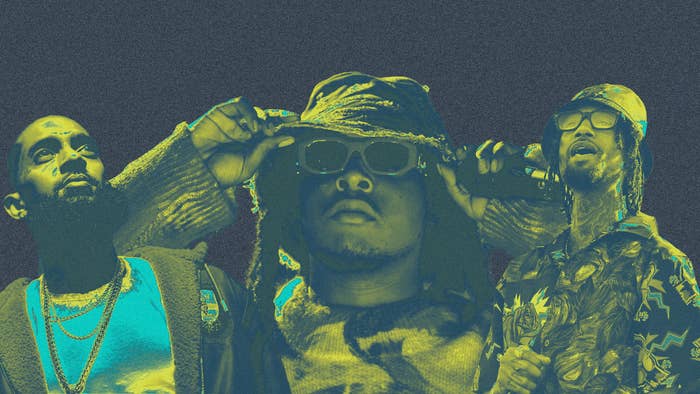
“Human beings are obsessed with mortality, as long as it isn’t their own,” broadcaster and current artist relations specialist Karlie Hustle tells Complex. “It is with a perverse curiosity that people click, tap, and scroll through images and videos of Black death. Who is the audience for this ‘online content’? And who stands to be paid for it?’”
This month, the hip-hop community received an unexpected bout of whiplash as news of Takeoff’s shooting death went public on Nov. 1. Details were doused across timelines as unconfirmed reports spread across the internet. One of the earliest posts came from popular hip-hop platform and gossip facilitator SAY CHEESE! which quoted its sources as club promoters in Houston on Twitter. TMZ wasted no time publishing a more holistic article that claimed the rapper had died the same morning. The article included a watermarked photo of Takeoff’s final moments, and a video clip that was soon lifted from their platform only to be reposted.
The behavior displayed across the digital realm this month is indicative of years of established practice and convention. Media personality Akademiks regularly inserts himself into hip-hop beef, how deaths have “happened” and general rumors, and has been particularly vocal about the ongoing Tory Lanez and Megan Thee Stallion court case involving the August 2020 shooting of the latter rapper. Furthermore, last week Dancehall juggernaut Spice was reported dead after BBL complications speculated on by social media users. She later addressed the false reports on social media, revealing that she instead suffered hernia damage.
The growth of the internet has bred a culture of schematic documentation which has allowed users to take the uncovering of new information—particularly the more provocative, salacious or sinister stories—into their own hands. As a result, we’ve seen average joes and “citizen journalists” simultaneously playing the roles of unqualified journalist and detective.
As social media has grown, it has democratized the media landscape, allowing many more voices to spread urgent information in real time, with quality smartphones at their disposal. Although this has allowed for the illumination of events such as on-the-ground protest reporting via Twitter threads and the frequent amplification of GoFundMe campaigns for the most vulnerable across the world, the landscape has also heightened the documenting and prioritization of violence and atrocities in real time, sometimes even sensationalizing elements of this. From watching Grenfell Tower crumble to pieces on the formerly Twitter-owned Periscope in 2017, to clips of UK rappers Headie One and Tion Wayne fighting on a flight from Dubai to London in 2020, audiences have been primed, and have become accustomed, to this way of reporting amidst, or sometimes even in lieu of, more conventional forms of reported journalism.
In the world of rap, the display of brutalized Black bodies is a regular occurrence. Just weeks ago, as singer and rapper PnB Rock’s body lay in his own blood, blogs and social media users circulated the clips of his murder with the ease of a few clicks. Similarly, George Floyd and Nipsey Hussle’s deaths were documented and spread in 2020 and 2019 respectively. Still—despite conversations that happen in echo chambers in which the moral obligation or tact behind posting these clips is questioned, alongside calls to respect family members—a cyclical approach to disseminating news of Black rappers’ violence in the most obscene ways persists amongst rap consumers, media, and beyond.
Esteemed journalist and reporter at Complex Shawn Setaro processes: “I think that one main reason for the wider sharing of graphic footage of crime scenes and violence is that, thanks to the explosion of smartphones, there’s exponentially more footage that exists. Prior to most people having a good-quality video recorder and camera in their pocket, there was far less video, and far fewer photos, of violent incidents.”
“Tabloids may get clips of white artists or citizens, but we’ve never seen [them treated] to the scale that it is when police brutality or harm to Black people is being sought after.”
Beyond the world of rap, Black bodies across American history, and in most Western societies are politicized and treated as disposable and therefore subject to a lack of respect. Breonna Taylor and Eric Garner are two of many examples of Black people who have also been subject to a lack of respect both in life and death. Their bodies have been used as social commodities, being spread across the internet as part of a culture of “torture porn” manifests across racial lines. A culture of desensitization has in turn permeated a generation of digital natives… Culture journalist, documentarian, and DJ Jesse Bernard concurs.
“Media has this weird relationship with [Black death] and how it’s displayed,” Bernard tells Complex. “Tabloids may get clips of white artists or citizens, but we’ve never seen [them treated] to the scale that it is when police brutality or harm to Black people is being sought after,” he argues. Setaro adds that we “shouldn’t ignore the historical context of Black bodies being used as a means of political intimidation” over time. The torture and subsequent lynching of Emmett Till in 1955 and the wide display of lynchings across North America historically corroborate this assertion.
Rap heightens the ability for media to display brutalized Black bodies, by way of gangster rap which parlayed into the artform across the ‘80s and conflates the artform for rappers deserving and being subject to death as an only outcome. Platforms like Fox attribute it to being a primary cause of violence, whilst controversial figures like Lakeith Stanfield argue that you can’t be pro-Black if you consume the genre. Over time, we’ve seen many a figure revered for overcoming violence, documenting violence on wax, and still traversing their muddier realities whilst pursuing a rap career. 50 Cent is positioned as one of these figures, particularly on his “Guess Who’s Back” mixtape debut and Get Rich or Die Tryin’ album, both of which followed his 2000 nine-time shooting.
“Who is the audience for this ‘online content’? And who stands to be paid for it?’”
“Rappers are treated as martyrs,” Vanessa Adams, a music marketing specialist, tells us. “[Being a martyr] gives news outlets and people more of a reason to argue that their death was because of their environments or circumstances.”
In other words, rappers being viewed as figures frequenting more heinous environments to their counterparts across musical genres, means that they are viewed as more susceptible to death and thus figures worthy of less respect, victimhood, or empathy. These elements, tied in with the vast majority of rap being dominated by Black people, can intersect with the aforementioned being displayed. In the case of Takeoff, media personality Jason Lee promoted the anti-Black myth of “Black on Black crime” on Twitter.
Even in an environment that has been proven to feature fictional lyricism and storylines via rappers such as Future and Rick Ross, the public and media continue to treat the genre as a space riddled in complete truths when it comes to lyrical content that discusses threats, violence, or murder. At times, it feels the genre is constantly on trial and deemed to be in need of reprimand.
Drill lyrics are even being used in courts across the UK and US monthly to heighten the belief that rappers—particularly Black ones—aren’t viewed as artists or multi-faceted beings, just arbiters of murder and despair and therefore lower-class creators. This mentality contributes to how they are exploited in death, too. In life, successful Black rappers are often treated as objects to be glorified, inspected and used as bargaining chips for digital commerce and clout. Their humanity then matters in the brief point between being used for commerce, engagement, and brand building and before complete discard.
“Rappers are treated as martyrs.”
Digital media continues to face an issue with erasure of facts, process in reporting, and an overall reckless approach to documenting sensitive issues on social media. Culture editor and journalist Elijah C. Watson recently supported that notion when he discussed the blurring of lines between hip-hop journalist and personality. The lack of ethics in reporting from personalities who pose as journalists not only exists, he writes, but is growing year by year. This behavior can lead to carelessness and competition to be first when sharing details of a person’s death. Fundamentally, this erodes process and therefore tact as it pertains to fact-checking, disclaimers, and releasing new developments and witness reports. Former music lawyer and director of repertoire strategy Christel Kayibi shares that there’s little legal obligation around seeking copyrighting for footage of a rapper dying, but believes they deserve a form of legal binding when it comes to the control individuals have to share clips of that nature.
“I don’t know what I would call it,” she begins. “But there should be a right for somebody who is seeing harrowing clips of something brutal happening to their family member to stop them seeing it. Maybe a right-to-privacy sort of stance. But it’s such a hard topic because of social media and why and how we use it.”
The exploitation of Black rappers’ deaths is part of a larger societal truth as it pertains to modern day media and social media consumption. When digital natives are committed to documenting each and every moment, death simply falls in line with that as one of the more grander, more scandalous forms of activity. In a toxic environment prioritizing clicks, engagement, and reach, blogs and individuals fall in line, scrambling to be first—however disastrous that quest is. In the content economy, rap is discarded, as a lack of due diligence echoes on and a lack of care toward Black rappers—and presumption that these rappers are destined for death—lingers. Hustle concludes, “Death as ‘online content’ is a cultural failure in an attention economy.”

